

Catch Fish with
Mike Ladle
Information Page
SEA FISHING
For anyone unfamiliar with the site always check the FRESHWATER, SALTWATER and TACK-TICS pages. The Saltwater page now extends back as a record of over several years of (mostly) sea fishing and may be a useful guide as to when to fish. The Freshwater stuff is also up to date now. I keep adding to both. These pages are effectively my diary and the latest will usually be about fishing in the previous day or two. As you see I also add the odd piece from my friends and correspondents if I've not been doing much. The Tactics pages which are chiefly 'how I do it' plus a bit of science are also updated regularly and (I think) worth a read (the earlier ones are mostly tackle and 'how to do it' stuff).
Now some lure fishing.
Spinning then and now! 2 Surface lures.
In the late 1990s surface popping lures gained a bit of a cult following with bass anglers. Steve Butler and Mike Hughes, who fished together in North Wales, were responsible for the first really successful attempts at surface water bassing. It was four or five years later that I began to use these lures and, at this point, I knew nothing about fishing with them (other than what I had been told by Mike and Steve). My first introduction to 'popping' was when my pal Alan Vaughan paid a visit to me down in Dorset. Alan had fished with Steve in Wales and was quite excited about the potential of these lures.
Surface poppers are essentially cylindrical or fish-shaped plugs with flat or dished faces. They can be quite big and bulky so they will often cast a good distance. They float, tail down, and fish on the surface of the water. When the line is twitched or jerked the lure splutters, pops and throws up a spray of water droplets. The size of the commotion depends on the area and shape of the lure's face, and how hard you jerk the line. The splashing resembles the disturbance caused by baitfish spraying from the surface when a predator strikes. No doubt the sound and splashing has the effect of attracting bass which can see or hear the commotion, and know exactly what it means.
The methods of fishing with these surface lures range from a fast, straight (or zig-zag), sliding retrieve, which leaves a wake across the surface, to little twitches interspersed with long pauses. A fast, steady retrieve catches some bass (and it was certainly an excellent method for luring barracuda, jacks, houndfish and tarpon when I was on holiday) but I've tended to use a twitch and pause approach for my bassing. There are an infinite number of such twitch and pause combinations. I have now caught a lot of bass by giving a couple of sharp, explosive tugs separated by two to four second pauses but longer pauses and lesser twitches may at times be more effective. The reactions of the fish will, of course, differ according to conditions. Flat calm seas are often good for this approach but the fish sometimes take well in choppy water.
In the early days virtually all my fish took the lure when it was more or less stationary (I am sure that this is not always the case). It will be obvious that, if the bass grabs a 'dead', immobile lure; razor sharp hooks and a tight line will be essential to success. Using non-stretch, braided lines (does anyone not use them now?) gives a firm contact, with taking fish provided the line is taut. The rod simply pulls over as the bass turns away and hooks itself. I guess that stretchy line and/or a soft actioned rod could mean some missed fish. Correspondence in the Bass Angler's Sportfishing Society journal confirms that this may be the case. I understand that some anglers in North America, where lures of this type were developed, do not work poppers by waving the rod about but simply point the rod at the 'plug' and turn the reel to produce the popping movement. This obviously helps to keep close contact with the lure. I've found that it also minimises the risk of fouled lures and reduces the chance of, so called, 'wind' knots in the braid on subsequent casts; this is how I usually fish now anyway.
Poppers of various types fish literally right on the surface and can be retrieved with confidence over the roughest, weediest ground. This can sometimes give a big advantage over even shallow diving plugs. However, loose, drifting weed, sea grass and indeed any bits of rubbish can drape the hooks of either type of lure - so they are not, the perfect bass lure. However, fished with care - and a huge slice of luck - you probably only ever need to buy one popper or slider and it could last you for life.
The old Chug Bug; it looked a bit like a stick of rock but caught plenty of bass.
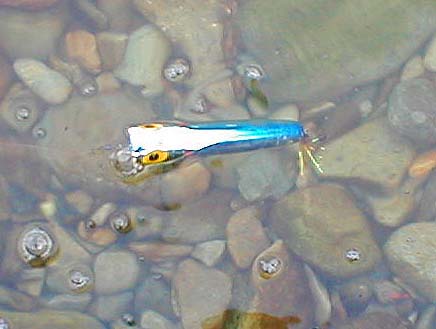
No monster but, my first ever fish on a surface lure.
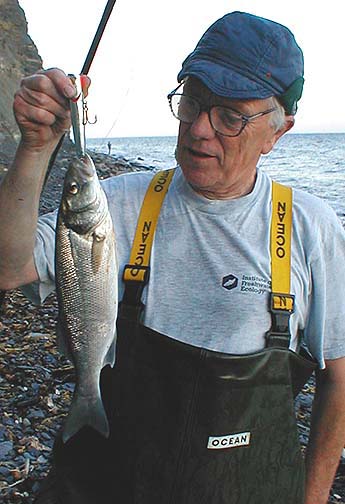
My friend Allan Hughes (now living in Australia) with a better Dorset fish on a popper.
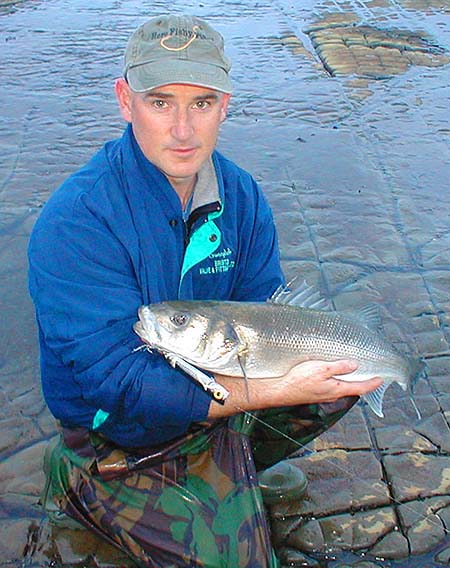
The Rapala Skitterpop which causes a good, big commotion for minimum effort.
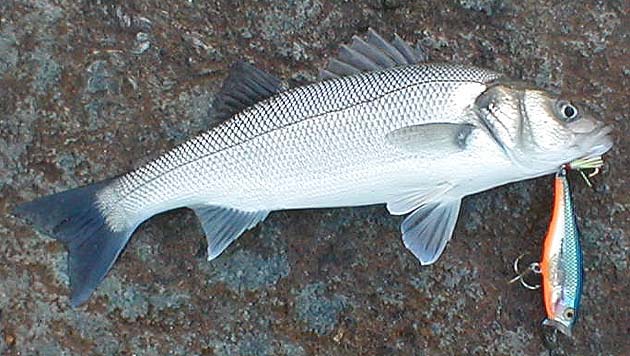
Another modest one for me, this time on a Skitterpop.
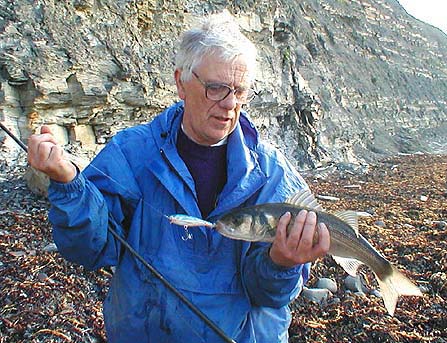
The tide running hard through a gap - ideal for using a slider.
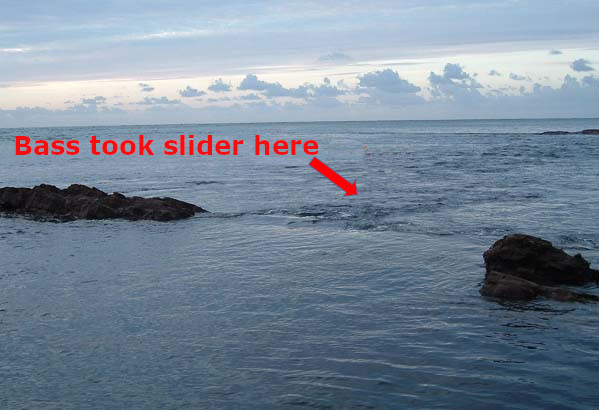
A fish hooked on a Yo-Zuri Mag Popper (a now extinct 'slider'). Note the slightly-dished, slanting face.
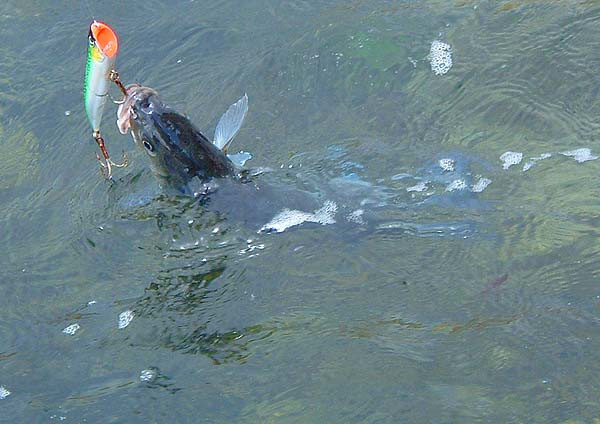
As I've already suggested bass are by no means the only species with a liking for surface lures. I've now used them extensively on holiday trips to warmer seas, and they are superb attractors for a number of large, fast-swimming species. As a general rule the best thing to do in this case is simply to wind as fast as possible and hang on tightly. Jacks are particularly susceptible and often show at the surface when they blitz their prey close to the shore. These fantastic fish are often more or less ignored in the light of bonefish, permit, tarpon, barracuda, kingfish, tuna and various 'more popular' species (several of which are also keen on surface lures).
I'll just recount one trip to Tobago (many years ago now) when my son Richard, Steve Pitts and myself were just learning how to tackle the shore fishing. The tone was set on our first evening. After picking up the hire car and dumping our gear we had just time for half-an-hour or so before the sun went down. We visited a small sandy bay backed by low cliffs and bounded at either end by rocks. On the last day of my previous trip I had missed a big fish which struck at a surface lure in the same spot, so I was keen for another go. We had assumed that the big fish which I had missed was either a tarpon or a large barracuda - both of which occur there. We already knew that barracuda took fast moving poppers and sliders keenly.
All three of us fished with different lures and after my last experience of a surface strike I tied on a Skitterpop. The gear was my 'travel bass rod' (an 11foot, 2.25lb TC) and my usual fixed spool reel loaded with 30lb Whiplash braid. A wire trace was added in anticipation of barracuda. We spread out along the beach but I hung around the spot where I had failed to hook the big fish. As I say, the technique was to chuck the popper out and then winch it in as fast as I could, creating a wake on the surface. After half-a-dozen casts suddenly the water erupted and I was into a fish. I held an arm in the air and waved to the others to signal that I was in action (Even with my voice it's no good shouting against the noise of the surf). Richard and Steve soon joined me and we all enjoyed the battle as the fish ran powerfully and repeatedly, out and along the beach. When we saw that it was a good jack we were thrilled. It was several minutes before the fish tired and could be tailed ashore with a gloved hand (the tail wrists are almost like razor blades). I was exhausted by the excitement of the struggle and we all agreed that it was the perfect start to the week's fishing.
I'm in as the sun goes down.
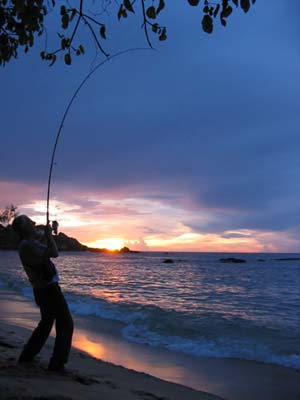
What a fish!
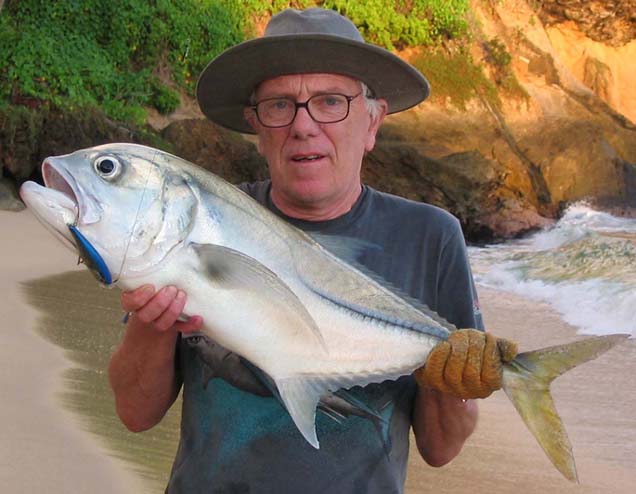
Richard with a decent jack almost on the sand.
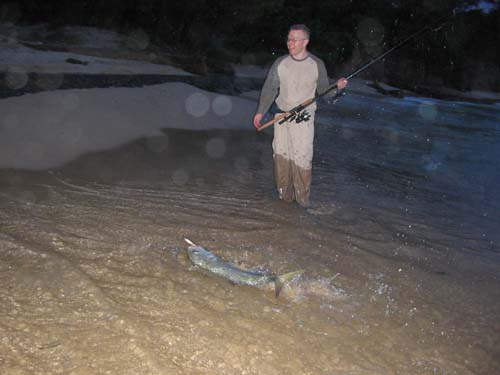
Another satisfied angler.
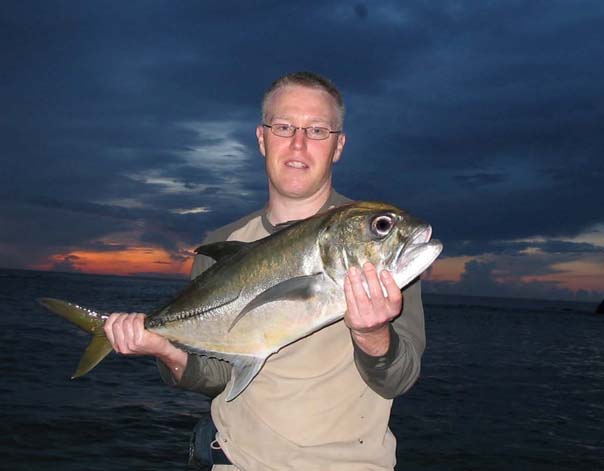
What a fish for Steve! Caught on a similar lure.
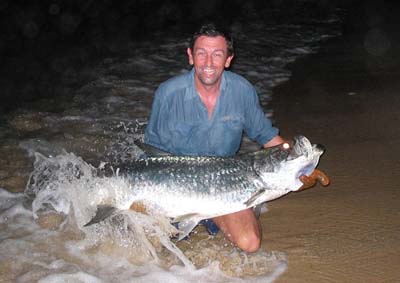
Hopefully these accounts give a flavour of the excitement to be gained from surface lure fishing. This tactic may not always be the most productive but when you see that boil as a bass smashes into your lure and feel the rod wrenched round, it may just be one of your more memorable fishing experiences.
If you have any comments or questions about fish, methods, tactics or 'what have you.'get in touch with me by sending an E-MAIL to - docladle@hotmail.com
– PLEASE TELL YOUR TWITTER, FACEBOOK, EMAIL FRIENDS ABOUT THESE BOOKS.
NEW BOOK
"Fishing for Ghosts - Successful Mullet Angling"
written with David Rigden IT'S AVAILABLE FROM -ALSO THE NEW BOOK
“The Second Wave”
Written with Steve Pitts this is a SEQUEL TO THE BESTSELLER "Operation Sea Angler" IT'S AVAILABLE ON PAPER OR FOR YOUR KINDLE FROM -